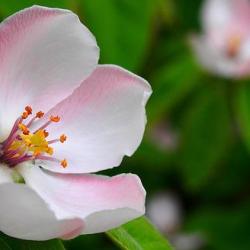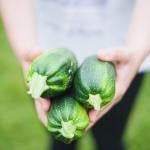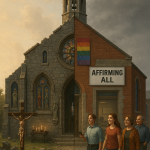
When I was ten years old, in the wake of a terrorist attack, I planted a white oak tree.
This was in the aftermath of the Oklahoma City bombing, shortly before the end of the fourth grade. I was at that terrible Catholic school in Columbus, Ohio, a world away from Oklahoma City, and my parents didn’t let me watch the news. I knew that a huge crowd of people had suffered a calamity, a long way away, and the whole country was in mourning.
I think that was the first of the American catastrophes Millennials have lurking in our memory: we were told, in elementary school, that some lunatic had blown up a building with fertilizer and killed scores of people, and the country was in shock, and we ought to be in shock as well. To heal our shock, we were each given a baby tree to plant as a memorial.
There were three different kinds of tree to choose from. Mrs. Carter, the fourth grade teacher, had to take down our orders for the kind of tree we would like: the school was offering red oak, white oak, and sugar maple. The other children laughed at the words “sugar maple.” I didn’t laugh, because I’d heard the term before and I knew what a sugar maple was. I was always wandering around in the woods near my Methodist grandfather’s house, talking to the trees; in summer we would visit Maryland and West Virginia where I liked to get lost in the woods, and my lapsed Catholic grandfather would tell me the names of the different kinds of tree. Trees were very important to me.
The teacher called the roll, asking for our preference. Every other child in the fourth grade ordered a sugar maple, because it sounded so appealing.
I asked for a white oak, so that the white oaks wouldn’t feel sad to be unwanted. I had been unwanted so many times, and it hurt.
The next day we got our tiny saplings, with the root balls stuck in plastic grocery bags.
“I’m going to take this home and EAT IT!” said the boy who sat next to me, picking up the tree like a stalk of celery and pantomiming shoving it into his mouth.
“You can’t get sugar out of a sugar maple tree until it’s thirty years old,” I informed him.
He looked disappointed. “I’ll be forty by then!”
I took my white oak home and planted it in the side yard a good ways from the fence.
The tree grew large and healthy. I don’t know how I managed to get it to do that. Other things I brought home from school died within weeks: the lily bulb I planted in a baby food jar to study the roots, the tadpole I kept in a honey jar to study amphibians. The mirror I’d made from a square of glass and a square of reflective metal when we studied optics smashed in my coat pocket on the way home, and I worried about bad luck. The rock candy I tried to make in a glass of water when we studied the phases of matter never set up properly. But the tree I got because I was sorry for it, to commemorate a terrorist attack, took to the soil. At first my father had to remind himself to mow the lawn around it without running it over, but soon it got so big it was unmistakable.
Halfway through the fifth grade, I had my nervous breakdown and was taken out of school to homeschool, but the tree did just fine and kept growing. Pretty soon it was taller than I was and too thick to bend over. It grew two boughs like the letter V, and those boughs started sprouting limbs. I used to talk to the tree when I went outside to read my homeschool textbooks in quiet.
In 1999, around the time of the Columbine Massacre a world away in Colorado, which left the whole country in shock, my brother tried to climb my white oak. The oak was sturdy but it wasn’t THAT sturdy. One of the boughs ripped halfway off, and hung limp from a green strip of bark. My father said that would be the death of the sapling. The bough would die off entirely, and the rest of the tree was liable to catch bugs or diseases from such a deep injury. There was nothing we could do to save it.
I still felt sorry for the white oak that nobody wanted, so I refused to accept that it was doomed.
I went out to the side yard with the only tools I had, which were craft scissors and packing tape. I pushed the maimed bough back against the gaping wound and wrapped the bough and trunk in tape, trying to adapt the instructions I’d learned when I got my first aid badge in Girl Scouts. I talked to the tree to reassure it as I bandaged. I was nearly certain it wouldn’t work, but it did. The bough remained alive and sprouted a thousand little limbs, which kept growing.
In 2001, when I started taking college courses, just after the 9/11 terrorist attacks that left the country in shock, the white oak was no longer a sapling. It was a tree. We raked the bright orange leaves into piles and shoved the piles into garbage bags to keep the lawn neat. Somewhere along the line, the tape had peeled off the wounded bough. There was only a deep black scar in the rough gray bark going all the way around like a bracelet.
I left home for graduate school in 2006. I watched the Virginia Tech Massacre from the television in my dormitory in 2007. My parents sold their house the next year, my white oak went with it to the next owners, and I did not go back to Columbus for a decade and a half.
In the late winter of 2020, I watched the Covid 19 pandemic eat up the country. I watched the numbers of deaths shoot up, first code orange and then code red and then code purple, in my hometown of Columbus, and I could do nothing.
In the summer of 2020 I watched the Black Lives Matter demonstrations and the violent police backlash all over the country. I watched the police beating up innocent bystanders and throwing flash grenades onto porches. I saw armies of police cars parked across from the library I went to every week growing up. I heard about them torturing the homeless with rubber bullets near the building where my father used to work. I watched the National Guard drive a tank in front of the church where I was baptized. And there was nothing I could do but watch in shock.
I will be forty next year.
Those maples the other children took home are almost ready to tap for sugar.
Recently, I finally went home to Columbus for a visit.
I drove around my old neighborhood, past the house I grew up in.
There was my white oak, healthy, flourishing, towering higher than the house itself. The current owner had hung a hammock between it and the house. I wanted more than anything to get out of the car and hug it like an old friend, but of course I didn’t. I kept driving.
Sometimes things stay alive.
Mary Pezzulo is the author of Meditations on the Way of the Cross, The Sorrows and Joys of Mary, and Stumbling into Grace: How We Meet God in Tiny Works of Mercy.













